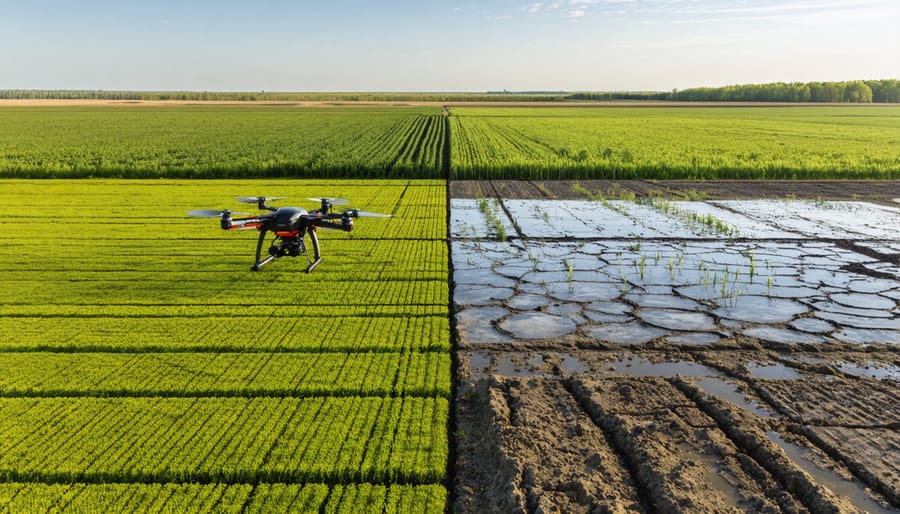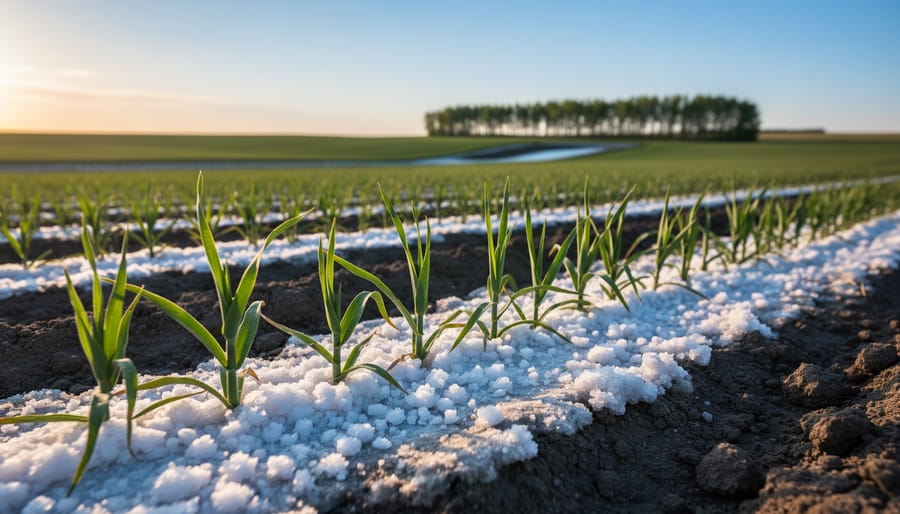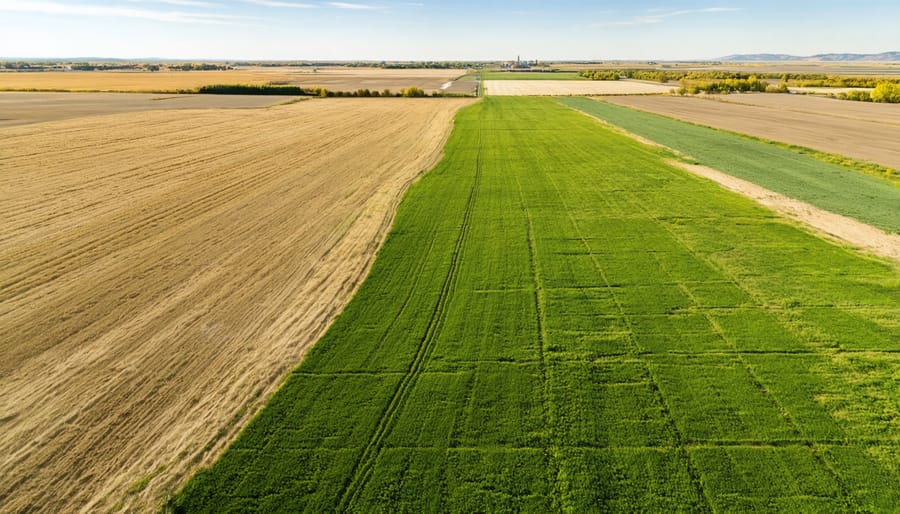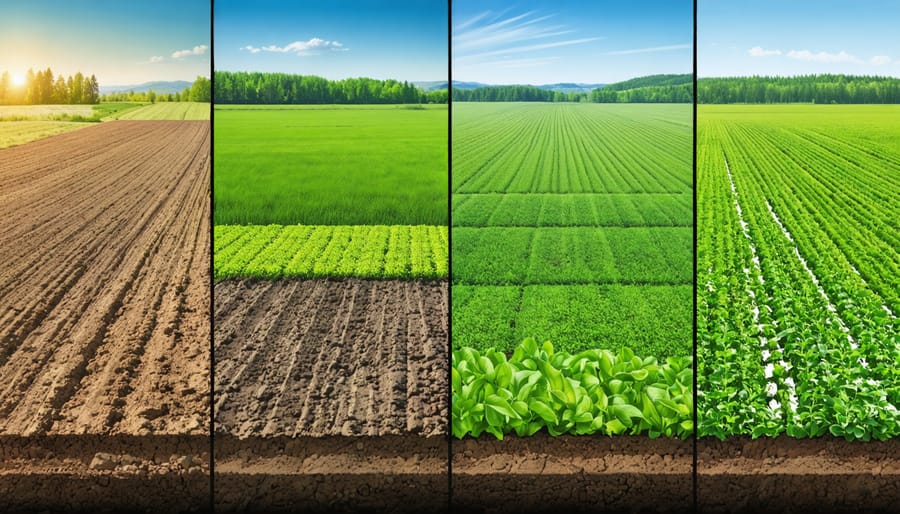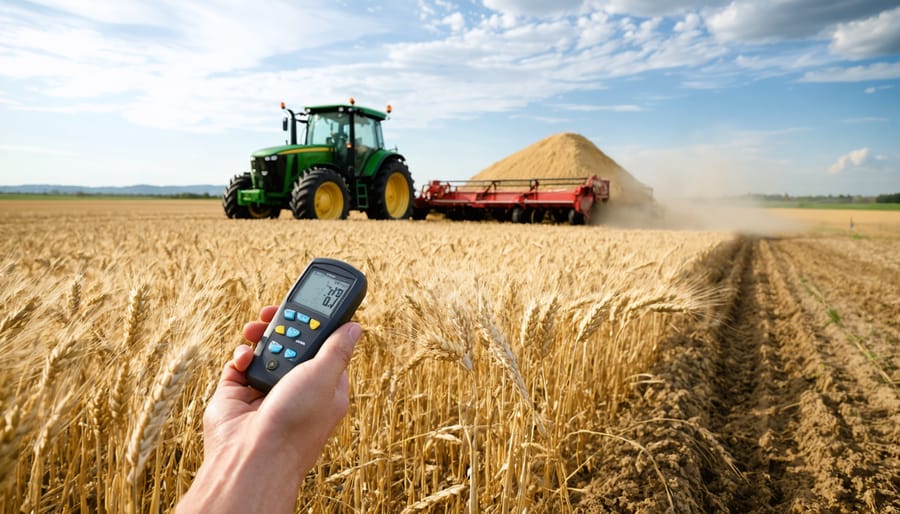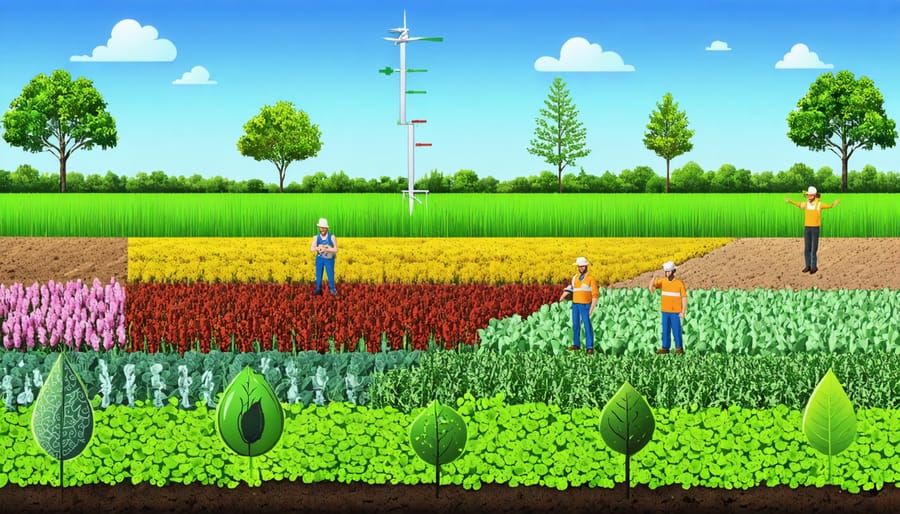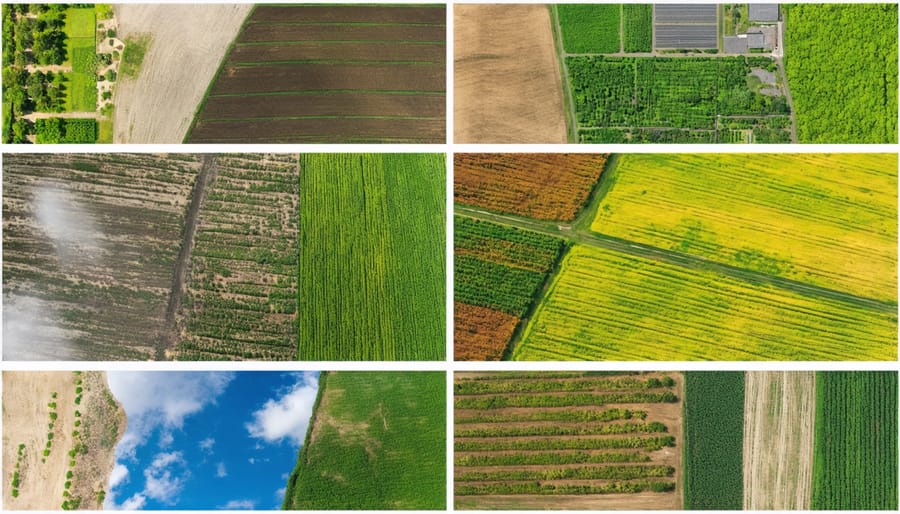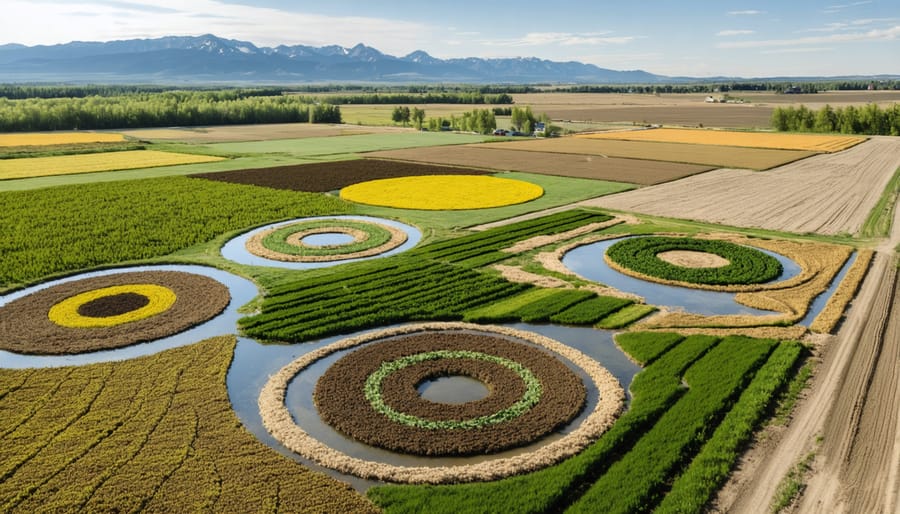Managing permafrost soil demands immediate action as Northern Alberta’s agricultural landscape continues to transform. Rising temperatures have destabilized once-permanently frozen ground, creating both challenges and opportunities for regional farmers. Through climate-resilient farming practices, producers are adapting to these shifting conditions while maintaining productive agricultural operations.
Recent soil monitoring data reveals that permafrost thaw affects over 40% of northern agricultural lands, fundamentally altering soil structure, drainage patterns, and nutrient availability. This transformation requires farmers to adopt innovative management strategies that balance immediate productivity with long-term soil stability. Understanding permafrost behavior isn’t just about preservation – it’s about harnessing changing soil conditions to create resilient agricultural systems that can thrive in Canada’s evolving northern climate.
Local success stories demonstrate that properly managed permafrost-affected soils can support diverse crop production while maintaining ecological integrity. By combining traditional knowledge with modern agricultural science, farmers are pioneering sustainable approaches that protect both their livelihoods and the unique northern ecosystem.
Understanding Permafrost Soil in Northern Alberta
Local Permafrost Distribution
In Northern Alberta, permafrost distribution follows distinct patterns that directly impact agricultural activities. The most significant permafrost zones are found north of Fort McMurray, with sporadic patches extending southward into the Peace River region. Recent mapping efforts by Alberta Agriculture and Forestry have identified that approximately 30% of agricultural land above the 58th parallel contains some form of permafrost.
Local farmers report that permafrost typically occurs in low-lying areas and north-facing slopes, where ground temperatures remain below 0°C for extended periods. The depth of permafrost varies considerably, ranging from 1 to 15 metres, depending on local conditions such as soil composition, vegetation cover, and drainage patterns.
Studies conducted by the University of Alberta show that permafrost distribution has changed significantly over the past three decades. Areas that were once permanently frozen are now experiencing seasonal thaw, creating new challenges and opportunities for agricultural development. This shift is particularly noticeable in the High Level and Fort Vermilion farming districts, where producers are adapting their land management strategies to account for changing ground conditions.
Understanding local permafrost patterns is essential for successful farm planning and soil management in these regions.
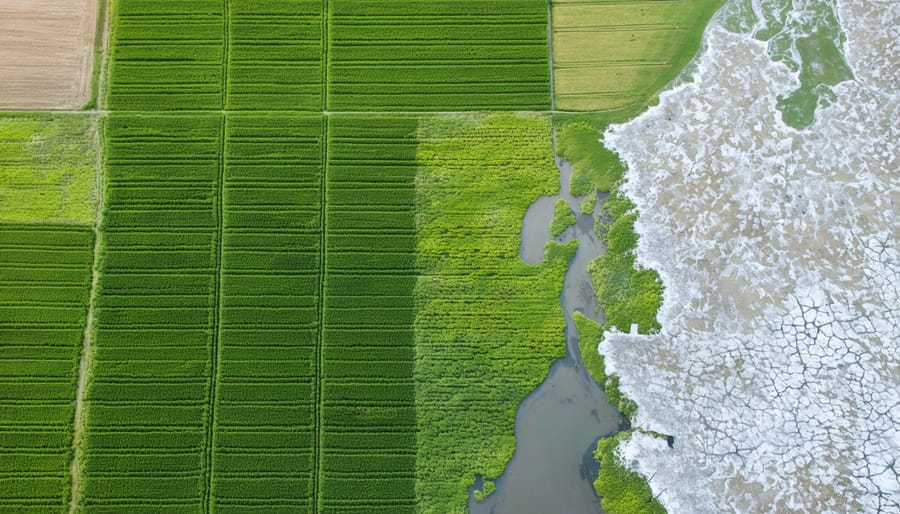
Seasonal Changes and Their Effects
In Northern Alberta, farmers experience distinct challenges as permafrost soil cycles through seasonal changes. During spring thaw, typically occurring between March and May, the upper layers of soil become increasingly unstable and waterlogged, making field access difficult for heavy machinery. This timing often delays crucial early-season operations by two to three weeks compared to non-permafrost areas.
Summer brings a brief window of opportunity when the active layer reaches its maximum thaw depth, usually 0.5 to 2 metres deep. However, the underlying frozen layer continues to affect drainage and root development. Local farmers have observed that late-summer planting of cold-hardy crops like barley and certain forage species tends to be more successful than early-spring seeding.
As temperatures drop in autumn, the freeze-thaw cycle creates frost heaving, which can damage plant roots and affect overwintering crops. Winter’s deep freeze stabilizes the soil again, but any protective snow cover is crucial for insulating both soil and dormant plants. Many Alberta farmers have adapted by adjusting their growing calendar and selecting crops that can thrive within these seasonal constraints, focusing on shorter-season varieties that mature before the fall freeze sets in.
Proven Management Techniques for Permafrost Soils
Surface Water Management
During the thaw season, effective water management strategies are crucial for maintaining soil stability and protecting crops in permafrost-affected areas. Installing proper drainage systems, including surface ditches and subsurface pipes, helps channel excess water away from fields during spring melt. Many Alberta farmers have found success with gentle slope grading, typically maintaining a 2-3% gradient that allows water to flow without causing erosion.
Creating buffer zones with native vegetation along field edges helps absorb excess moisture and prevents waterlogging. These natural barriers also reduce the risk of soil erosion during intense thaw periods. Installing monitoring wells at key points across your property allows you to track water table levels and adjust your management approach accordingly.
Snow management during winter months directly impacts spring thaw conditions. Strategic snow fencing and windbreaks help distribute snow evenly across fields, preventing excessive moisture accumulation in specific areas. Some farmers in Northern Alberta have implemented retention ponds to capture spring melt, which can later be used for irrigation during drier periods.
Regular soil moisture testing and maintaining detailed records of drainage patterns helps identify problem areas before they become serious issues. Working with local agricultural extension services can provide valuable insights into region-specific water management techniques that have proven successful in similar soil conditions.
Soil Insulation Methods
In Northern Alberta’s challenging climate, effective soil productivity management often depends on proper insulation techniques to maintain stable ground temperatures. Mulching stands out as a primary method, with locally sourced straw or wood chips creating an effective 15-20 cm thick protective layer that helps regulate soil temperature fluctuations.
Snow fencing strategies have proven particularly successful among Alberta farmers, who strategically place these barriers to trap snow and create natural insulation blankets during winter months. This technique can maintain soil temperatures up to 5°C warmer than exposed areas.
Ground cover crops like winter rye and clover serve a dual purpose, providing both insulation and soil enrichment. Many successful farmers in the Peace River region plant these covers in late summer, allowing them to establish before winter sets in.
Reflective ground covers, while less common, have shown promising results in test plots across Northern Alberta. These specialized materials reflect solar radiation during warmer months, helping to prevent unwanted thawing cycles.
For greenhouse operations and smaller plots, rigid foam insulation boards placed around perimeter areas have demonstrated excellent results in maintaining consistent soil temperatures. Local farmers report success with 5-10 cm thick panels installed vertically along field edges to depths of 0.5-1 metre.
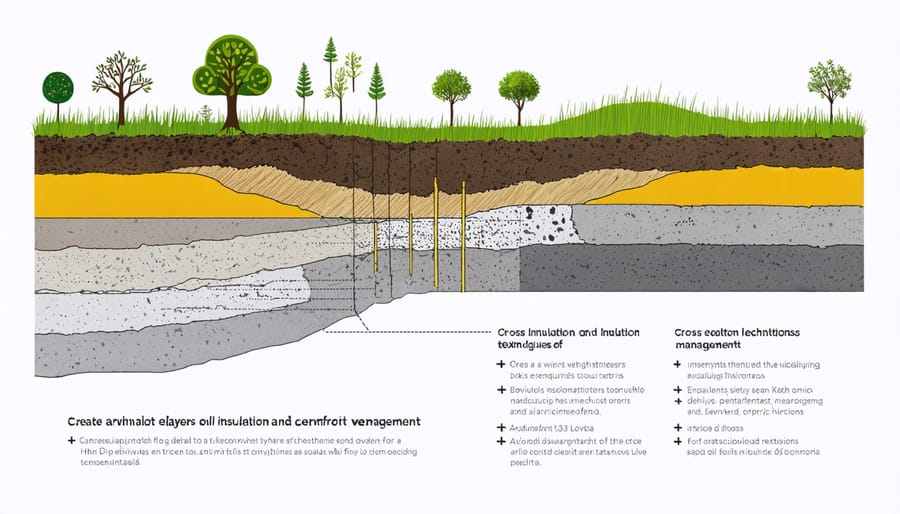
Crop Selection and Timing
In Northern Alberta’s permafrost regions, successful crop selection hinges on choosing varieties that can thrive in a shorter growing season and adapt to unique soil conditions. Hardy, fast-maturing crops like barley, oats, and certain wheat varieties have proven most successful, typically requiring 85-100 days to reach maturity.
Cold-tolerant vegetables such as kale, cabbage, and root crops (carrots, turnips, and potatoes) perform particularly well. These crops can withstand occasional frost and make efficient use of the intense summer daylight hours characteristic of northern latitudes.
Timing is crucial for maximizing yield potential. Most farmers in permafrost regions begin soil preparation as soon as the active layer thaws, usually in late May or early June. Planting should occur immediately after the last spring frost, typically between June 1-15 in most areas. Consider using cold frames or row covers to extend the growing season and protect young plants from late spring frosts.
Local farmer Mike Peterson from Peace River shares, “We’ve had great success with short-season canola varieties, which mature in about 85 days. Starting seeds indoors in March gives us a crucial head start.” Some farmers have also reported positive results with fall rye and winter wheat, which can be planted in late August and harvest the following summer.
For best results, consult with local agricultural extension offices to obtain specific variety recommendations and precise planting dates for your area, as these can vary significantly across different permafrost zones.
Success Stories from Northern Alberta
Peace River Valley Innovation
In the heart of Alberta’s Peace River Valley, local farmer Sarah Thompson has pioneered an innovative approach to managing permafrost-affected soil on her 300-hectare farm. Through a combination of traditional knowledge and modern techniques, Thompson has developed a system that’s helping crops thrive in challenging conditions.
“The key is working with the land, not against it,” Thompson explains. Her method involves strategic timing of field operations and the use of specially adapted cover crops that help insulate the soil during critical transition periods. By planting early-season crops with shallow root systems in areas where permafrost is closer to the surface, she’s been able to extend her growing season by nearly three weeks.
Thompson’s innovation includes a modified drainage system that manages water levels during the spring thaw, preventing oversaturation while maintaining soil stability. This approach has increased her farm’s productive acreage by 15% over the past five years.
The success of Thompson’s methods has sparked interest throughout the region, leading to the formation of the Peace River Agricultural Innovation Network. This group of local farmers meets monthly to share experiences and adapt their strategies for permafrost management.
“We’re seeing real results,” says Thompson. “Our yields have improved by 20%, and we’re helping preserve the soil structure for future generations.” Her approach is now being studied by agricultural researchers at the University of Alberta as a potential model for other permafrost-affected regions.
Fort McMurray Agricultural Adaptation
Fort McMurray’s agricultural community has emerged as a pioneer in developing innovative solutions for farming on permafrost-affected soils. Local farmers have formed the Fort McMurray Agricultural Society, which actively shares knowledge and resources to help members adapt their farming practices to changing soil conditions.
One notable success story comes from the Thomson Family Farm, where third-generation farmer Sarah Thomson implemented a modified drainage system that helps manage excess water from thawing permafrost. The system incorporates strategically placed drainage channels and raised bed farming techniques, resulting in a 30% increase in productive growing area over three years.
The community has also established a seed bank featuring cold-hardy crop varieties specifically selected for permafrost-challenged soils. These include modified strains of barley, oats, and various root vegetables that can thrive in shorter growing seasons and variable soil conditions.
Local agricultural extension programs offer workshops and field demonstrations throughout the year, teaching practical techniques for soil stabilization and crop management. These programs have helped over 100 local farmers implement adaptive strategies on their land.
The Fort McMurray initiative demonstrates how community-led solutions can effectively address permafrost challenges. Their collaborative approach has not only improved agricultural productivity but has also strengthened community resilience and knowledge sharing among northern farmers.
Future-Proofing Your Farm
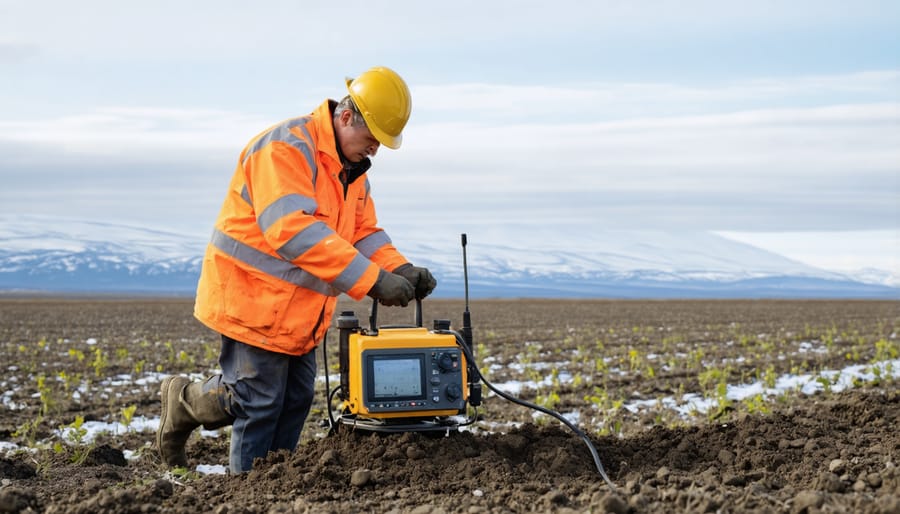
Monitoring and Assessment Tools
In Alberta’s changing northern landscape, keeping track of permafrost conditions is crucial for successful farming. Modern monitoring tools have made this task more manageable and precise than ever before. Ground temperature sensors, installed at various depths, provide real-time data about soil temperature fluctuations throughout the seasons. These sensors connect to data loggers that farmers can access through their smartphones or computers.
Thermal imaging drones have become increasingly popular among agricultural professionals, offering a bird’s-eye view of ground temperature patterns across larger properties. These surveys help identify areas where permafrost might be degrading or where drainage patterns are changing.
Soil moisture probes work alongside temperature sensors to track water content changes, which can signal permafrost thaw. Many Alberta farmers are now using probe networks that create detailed maps of their land’s moisture distribution.
The Agricultural Climate Network of Alberta provides free access to historical climate data and monitoring equipment rental programs. Local agricultural extension offices offer training on using these tools and interpreting the data they provide.
For those working with smaller budgets, simple frost tubes and manual temperature probes remain reliable options. Regular visual inspections of land features, such as ground subsidence or water pooling, complement these technological solutions. The key is maintaining consistent monitoring schedules and keeping detailed records to track changes over time.
Sustainable Adaptation Strategies
As our climate continues to shift, adapting to changing soil conditions has become essential for northern Alberta farmers. Successful long-term management of permafrost-affected lands requires a combination of innovative techniques and traditional knowledge.
Consider implementing cover cropping systems that protect soil during shoulder seasons. Deep-rooted plants like alfalfa and native grasses help stabilize soil structure and improve drainage patterns. Many Alberta farmers have found success with controlled drainage systems that manage water levels throughout the growing season.
Creating windbreaks using native tree species can help regulate soil temperature and reduce erosion. Local success stories include the Watson family farm near Peace River, where strategic tree placement has helped maintain soil stability for over fifteen years.
Monitoring systems are crucial for tracking soil changes. Install temperature sensors at various depths and maintain detailed records of frost patterns. This data helps inform planting schedules and crop selection decisions.
Consider diversifying your crop rotation to include cold-hardy varieties that can thrive in shorter growing seasons. Work with local agricultural extension services to identify suitable crops for your specific soil conditions.
Remember that adaptation is a community effort. Join local farmer networks to share experiences and solutions. The Northern Alberta Permafrost Management Network offers regular workshops and mentorship opportunities for farmers facing similar challenges.
As Alberta’s agricultural landscape continues to evolve with changing permafrost conditions, our farming community stands ready to adapt and thrive. By implementing proper soil monitoring techniques, adopting sustainable drainage systems, and selecting climate-appropriate crops, we can effectively manage permafrost-affected lands. Remember to regularly assess soil temperature and moisture levels, maintain detailed records, and engage with local agricultural extension services for support.
Consider joining regional farmer networks to share experiences and learn from others facing similar challenges. Take advantage of available government resources and funding programs designed to support sustainable farming practices in permafrost regions. Through collective knowledge and action, we can preserve our agricultural heritage while building resilient farming operations for future generations.
Together, we’re not just adapting to permafrost conditions – we’re pioneering sustainable farming practices that will benefit our entire agricultural community.

